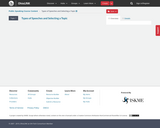
189 Results


Learning Objectives
Understanding Research
Source Types
Academic
Nonacademic
Evaluating Sources
Incorporating Research
Plagiarism
Avoiding Plagiarism
Source Documentation Styles
How to Parenthetically Cite
Source Pages
How to Verbally Cite
- Subject:
- Business and Communication
- Communication
- Material Type:
- Diagram/Illustration
- Date Added:
- 09/28/2023

This video covers concepts related to searching within academic research databases, using EBSCO's Academic Search Complete and ProQuest Central as examples. Concepts covered are: using the advanced search, limiters, Boolean operators, citing from a database, and more. Concepts related to information literacy and research skills are covered.
- Subject:
- Business and Communication
- Communication
- Material Type:
- Lesson
- Author:
- Vanessa Garofalo
- Date Added:
- 09/28/2023

Google Slides presentation covering persuasive appeals, forms of reasoning, constructing arguments, and logical fallacies.
- Subject:
- Business and Communication
- Communication
- Material Type:
- Reading
- Date Added:
- 09/29/2023

A brief tutorial on researching and using supporting materials in public speaking. Topics include types of supporting materials, where to find supporting materials, and evaluating sources.
- Subject:
- Business and Communication
- Communication
- Material Type:
- Lesson
- Provider:
- COMMPadres Media
- Date Added:
- 09/28/2023

This book is intended for the Risk Management and Insurance course where Risk Management is emphasized.
When we think of large risks, we often think in terms of natural hazards such as hurricanes, earthquakes or tornados. Perhaps man-made disasters come to mind such as the terrorist attacks in the U.S. on September 11, 2001. Typically we have overlooked financial crises, such as the credit crisis of 2008. However, these types of man-made disasters have the potential to devastate the global marketplace. Losses in multiple trillions of dollars and in much human suffering and insecurity are already being totaled, and the global financial markets are collapsing as never before seen.
We can attribute the 2008 collapse to financially risky behavior of a magnitude never before experienced. The 2008 U.S. credit markets were a financial house of cards. A basic lack of risk management (and regulators' inattention or inability to control these overt failures) lay at the heart of the global credit crisis. This crisis started with lack of improperly underwritten mortgages and excessive debt. Companies depend on loans and lines of credit to conduct their routine business. If such credit lines dry up, production slows down and brings the global economy to the brink of deep recession—or even depression. The snowballing effect of this failure to manage the risk associated with providing mortgage loans to unqualified home buyers have been profound, indeed. When the mortgages failed because of greater risk- taking on the Street, the entire house of cards collapsed. Probably no other risk-related event has had, and will continue to have, as profound an impact world wide as this risk management failure.
How was risk in this situation so badly managed? What could firms and individuals have done to protect themselves? How can government measure such risks (beforehand) to regulate and control them? These and other questions come to mind when we contemplate the consequences of this risk management fiasco.
Standard risk management practice would have identified sub-prime mortgages and their bundling into mortgage-backed-securities as high risk. People would have avoided these investments or would have put enough money into reserve to be able to withstand defaults. This did not happen. Accordingly, this book may represent one of the most critical topics of study that the student of the 21st century could ever undertake.
Risk management will be a major focal point of business and societal decision—making in the 21st century. A separate focused field of study, it draws on core knowledge bases from law, engineering, finance, economics, medicine, psychology, accounting, mathematics, statistics and other fields to create a holistic decision-making framework that is sustainable and value- enhancing. This is the subject of this book.
- Subject:
- Business and Communication
- Material Type:
- Textbook
- Provider:
- The Saylor Foundation
- Author:
- Etti Baranoff
- Patrick Lee Brockett
- Yehuda Kahane
- Date Added:
- 11/09/2021

Small Business Management in the 21st Century offers a unique perspective and set of capabilities for instructors. The authors designed this book with a “less can be more” approach, and by treating small business management as a practical human activity rather than as an abstract theoretical concept.
- Subject:
- Business and Communication
- Management
- Material Type:
- Textbook
- Provider:
- The Saylor Foundation
- Author:
- David Cadden
- Sandra L. Lueder
- Date Added:
- 11/09/2021
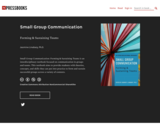
Small Group Communication: Forming & Sustaining Teams is an interdisciplinary textbook focused on communication in groups and teams. This textbook aims to provide students with theories, concepts, and skills they can put into practice to form and sustain successful groups across a variety of contexts.
- Subject:
- Business and Communication
- Communication
- Material Type:
- Textbook
- Author:
- Jasmine Linabary
- Date Added:
- 10/31/2021
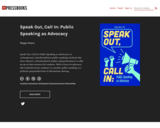
Speak Out, Call In: Public Speaking as Advocacy is a contemporary, interdisciplinary public speaking textbook that fuses rhetoric, critical/cultural studies, and performance to offer an up-to-date resource for students. With a focus on advocacy, this textbook invites students to consider public speaking as a political, purposeful form of information-sharing.
- Subject:
- Business and Communication
- Communication
- Material Type:
- Textbook
- Provider:
- University of Kansas
- Author:
- Meggie Mapes
- Date Added:
- 11/05/2021

Speaking in public is consistently ranked in people's top fears, more so than flying, drowning, creepy crawly critters, and zombies.
- Subject:
- Business and Communication
- Communication
- Material Type:
- Lesson
- Date Added:
- 09/19/2023
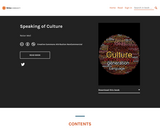
The purpose of Speaking of Culture is to define culture and many other concepts associated with it. My hope is that the readings in this book will help you to better understand the breadth of the concept of culture and provide you with a vocabulary for discussing it more articulately.
Culture is one of those broad concepts that is used widely, although somewhat imprecisely, in everyday English. It also cuts across many academic disciplines, and this book draws on many of them. It touches, for instance, on anthropology, biology, history, mythology, political science, psychology, and sociology.
- Subject:
- Arts and Humanities
- Business and Communication
- Communication
- Social Science
- Sociology
- World Cultures
- Material Type:
- Textbook
- Author:
- Nolan Weil
- Date Added:
- 04/27/2020

In some respects, public speaking isn’t all that different from a vacation; it should involve planning and purpose. Once you have selected a topic (or destination) for your speech, it’s important to take care with the details and make sure that your content is going to line up with the purpose of the speech. This video discusses the process of developing a general purpose statement, specific purpose statement, and central idea statement for a speech.
- Subject:
- Business and Communication
- Communication
- Material Type:
- Lesson
- Provider:
- COMMPadres Media
- Date Added:
- 09/27/2023
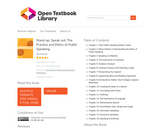
From audience analysis to giving a presentation, Stand up, Speak out: The Practice and Ethics of Public Speaking will guide students through the speech making process. The authors focus on the process of speech making because they have created this book to be a user-friendly guide to creating, researching, and presenting public speeches. While both classic and current academic research in public speaking guide this book, the authors believe that a new textbook in public speaking should first, and foremost, be a practical book that helps students prepare and deliver a variety of different types of speeches — and that is the primary goal of this book.With practicality in mind, the authors developed, Stand up, Speak out: The Practice and Ethics of Public Speaking, as a streamlined public speaking textbook. Many public speaking textbooks today contain over twenty different chapters, which is often impossible to cover in a ten-week quarter or a sixteen-week semester; this textbook is eighteen unique chapters. The fifteen chapters are divided into four clear units of information: introduction to public speaking, speech preparation, speech creation, and speech presentation.
- Subject:
- Business and Communication
- Communication
- Material Type:
- Textbook
- Provider:
- University of Minnesota
- Provider Set:
- University of Minnesota Libraries Publishing
- Author:
- Jason Wrench, Anne Goding, Danette Johnson, Bernardo Attias
- Date Added:
- 01/01/2011
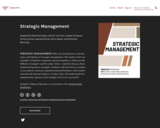
STRATEGIC MANAGEMENT offers an introduction to the key topics and themes of strategic management. The authors draw on examples of familiar companies and personalities to illustrate the different strategies used by today’s firms—and how they go about implementing those strategies. Students will learn how to conduct a case analysis, measure organizational performance, and conduct external and internal analyses. In short, they will understand how organizations operate at the strategic level to be successful.
- Subject:
- Business and Communication
- Management
- Material Type:
- Textbook
- Provider:
- Virginia Tech
- Author:
- Kennedy B. Reed
- Date Added:
- 11/09/2021
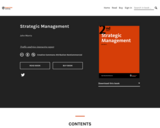
This open source textbook is derived from many sources, initially from the Principles of Management by Carpenter, Bauer, and Erdogan, but there is abundant new content as well. It is published under a Creative Commons license and as such there is no charge ever for this textbook.
- Subject:
- Business and Communication
- Management
- Material Type:
- Textbook
- Provider:
- Oregon State University
- Author:
- John Morris
- Tobias Hodges
- Date Added:
- 11/03/2021
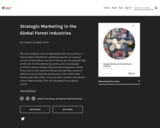
The forest industry is increasingly global and every marketer of forest products should have a global perspective. As a natural resource-based industry, the forest industry has an especially high profile role in environmental protection and is increasingly involved in climate change mitigation and management. Global forests are not only important because they provide a source of industrial raw material, but also because of the various other human needs they satisfy. A forest products marketer should have a basic understanding of the role that global forests play in society. Major societal trends are impacting the external environment within which the forest industry operates. We provide an overview of global forests and a brief description of the markets for the main categories of the forest industry.
- Subject:
- Business and Communication
- Marketing
- Material Type:
- Textbook
- Provider:
- Oregon State University
- Author:
- Eric Hansen
- Heikki Juslin
- Date Added:
- 11/03/2021

This book is suited for the Entrepreneurship or Innovation course with an emphasis on Sustainability or for a course devoted entirely to Sustainability.
What are the trends and forces underlying the changing character of the business-environment relationship? How they are creating significant entrepreneurial opportunities for individuals and companies? Around the world, the movement toward “sustainable development” has caused many firms to adopt policies and practices that reflect what is sometimes called a “sustainable business” or “triple bottom line” approach. “Triple bottom line” refers to the demonstration of strong performance across economic, social, and environmental indicators. Those measures serve as indicators of fiduciary responsibility to a growing set of concerned investors and therefore can help ensure access to capital. They also enable innovators to lower costs, create strategic differentiation, reduce risk, and position themselves for competitive advantage over rivals less attuned to trends.
The deep roots of sustainability thinking are now evident in widespread and increasingly visible activities worldwide, and Sustainability, Innovation, and Entrepreneurship explores this evolution; its necessity, its implications and its progression.
- Subject:
- Business and Communication
- Economics
- Social Science
- Material Type:
- Textbook
- Provider:
- The Saylor Foundation
- Provider Set:
- Saylor Textbooks
- Author:
- Andrea Larson
- Date Added:
- 01/01/2011

The issue of sustainability and specifically sustainable business is of increasing interest and importance to students of business and also students in the sciences, government, public policy, planning and other fields. There can be significant benefits from students learning about sustainable business from the rich experiences of business practice.
The Sustainable Business Case Book by Gittell, Magnusson and Merenda is one of the first of its kind. It combines the the theory of sustainability with key concepts, analytical information and contextual information with a collection of cases which provide insights, perspective and practical guidance on how sustainable businesses operate from different business functional area perspectives.
The Sustainable Business Case Book can be used as a stand-alone text or as a supplemental textbook for undergraduate courses that have an interest in sustainable business. While the book's primary focus is on the relationship between business and sustainability, the book can also be used in courses offered in fields other than business, including environmental and earth systems sciences, environmental studies, urban planning, economics and public policy.
The first part of The Sustainable Business Case Book, Chapter 1 through Chapter 3, introduces students to the meaning of sustainability, and the practice of sustainable business. The introductory chapters also describe key concepts, analytical frameworks, and contextual information relevant for the understanding of business sustainability. Chapter 1, defines sustainability and describes how and why businesses choose to engage in sustainable practices and how sustainable business practices relate to corporate profitability and social responsibility. Chapters 2 and 3 provide important background and contextual information affecting sustainable business practice. Chapter 2, The Science of Sustainability, reviews scientific evidence about climate change and the human and business influences on climate change. Chapter 3, Sustainability, Public Policy and Business, describes the significant role of government and public policy in sustainability, including setting the rules, regulations and laws that define the market and market opportunities for sustainable business practice.
- Subject:
- Business and Communication
- Material Type:
- Textbook
- Provider:
- The Saylor Foundation
- Author:
- Matt Magnusson
- Michael Merenda
- Ross Gittell
- Date Added:
- 11/09/2021

Sometimes the hardest part of public speaking is figuring out what to talk about. This video discusses the criteria that make a solid speech topic and provides some basic tips on generating ideas for speech topics.
- Subject:
- Business and Communication
- Communication
- Material Type:
- Lesson
- Provider:
- COMMPadres Media
- Date Added:
- 09/27/2023

Methods for identifying a purpose and topic for your presentation.
- Subject:
- Business and Communication
- Communication
- Material Type:
- Lesson
- Date Added:
- 09/28/2023